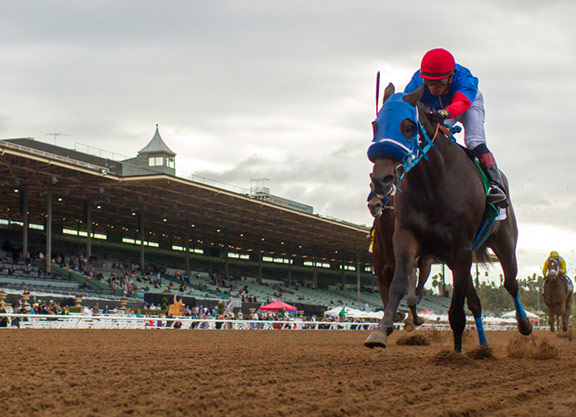By Dan Ross
Veterinarian Vince Baker and trainer Enebish Ganbat both insisted that contrary to swirling conspiracy theories, Mongolian Groom (Hightail), who suffered a catastrophic injury in Saturday's GI Longines Breeders' Cup Classic, was given a clean bill of health to run in the race.
Mongolian Groom's last workout was Sunday, Oct. 27, when he worked five furlongs on 1:02. Ganbat said on Tuesday that he was unhappy because he expected a faster breeze. “But he was not lame,” said the conditioner, about the reason for the slow work–rather, the time was a result of the saddle slipping back, he said. A video of that workout can be seen here.
Baker–Mongolian Groom's veterinarian since the horse arrived in California over two years ago, he said–told the TDN via telephone Wednesday that the horse “tied-up” after the workout, and afterwards, was muscle-sore along his back, catching the attention of regulatory veterinarians from the Breeders' Cup, Santa Anita and the California Horse Racing Board (CHRB).
“The regulatory group, including the Breeders' Cup, watched him train on Tuesday, Wednesday, Thursday, Friday, and on Thursday they said, 'now, he's completely normal,'” said Baker, who added that the horse was given the green light to race by the “best pre-race veterinarians” in the country.
“Every day they watched him on the track, and then they came back to the barn and checked him,” said Baker, who described Mongolian Groom as a “low-maintenance” horse, in terms of veterinary intervention, throughout his career.
Mongolian Groom's owners stumped up $200,000 to supplement the horse to the Breeders' Cup. Baker said that he had warned Ganbat the horse might be scratched from the Classic. “He was fine with that. Absolutely,” said Baker. Eight horses were scratched from both days of the Breeders' Cup.
Videos posted on social media prior to the Sunday, Oct. 27 workout appear to show Mongolian Groom jogging stiffly behind. According to Ganbat, the horse historically takes time to warm up in a jog. “His whole life, he was like this,” Ganbat said.
Between the Breeders' Cup, The Stronach Group and the CHRB, a team of 30 veterinarians were monitoring the Breeders' Cup horses. The Paulick Report reported that each Breeders' Cup horse was examined a minimum of five times in the span of a couple weeks leading up the contest.
Mongolian Groom suffered fractures to his left-hind pastern and lower left-hind cannon bone. According to CHRB records, Mongolian Groom was twice put on the vet's list for five days for treatments received on Aug. 2 at Del Mar, and on Oct. 19 at Santa Anita.
Baker said that those treatments were for intra-articular joint injections of hyaluronic acid and Vetalog (an anti-inflammatory used to treat things like arthritis) into the hocks. Baker said that the treatments had “zero” impact on the injury Mongolian Groom suffered Saturday.
“We know from that type of injury to the pastern, it is not a pre-existing problem–it is an acute injury,” said Baker, who added that Mongolian Groom had shown no prior problems or unsoundness issues at the site of the catastrophic breakdown. “It is an acute twisting injury–a typical turf injury, where a horse puts a foot into the surface and they twist on it but there's no give.”
The TDN reached out to The Stronach Group and the CHRB for comment. Both referred the TDN to the Breeders' Cup, whose spokesperson, Jim Gluckson cited a statement issued Saturday. In it, the Breeders' Cup announced that it had engaged “world-renowned veterinarian, Dr. Larry Bramlage, to conduct an independent evaluation, the results of which will be published when completed. We will continue to keep all stakeholders apprised as information becomes available.”
Ryan Carpenter was one of Mongolian Groom's attending veterinarians after Saturday's incident. Carpenter emphasized how the decisions surrounding Mongolian Groom's treatment Saturday were made with the horse's health and welfare foremost in mind.
“We evaluated him, he had a severe fracture, he had a questionable blood supply, and we know from our experience that those horses don't make it,” said Carpenter. “We could have prolonged the agony, which would have made it easier on us, because we could go back to the media and say, 'He's had a serious injury, he's having surgery tomorrow, a team of surgeons are coming in to get the job done, we'll keep you posted on how he does,” said Carpenter. “He would have probably lasted a week.”
That message is more palatable to the wider public, said Carpenter. “They interpret that as, 'you've tried-you didn't just discard the horse.' But we knew that wasn't the right decision for that particular horse and that particular injury.”
Baker said he believed that during Ganbat's near 9-year career, no horse in his care had suffered a catastrophic race-day injury (TDN hasn't independently verified this). “Ganbat loves his horses,” said Baker.
“With his 2-year-olds, if their shins get sore, I tell him we're going to back off and jog for 30-45 days, it's always, 'yes.' And that's what he does. I respect him as an individual and as a trainer,” said Baker.
“I am very sorry to Santa Anita and the Breeders' Cup,” Ganbat said on Tuesday. “And to everybody who loves horses.”
Not a subscriber? Click here to sign up for the daily PDF or alerts.






